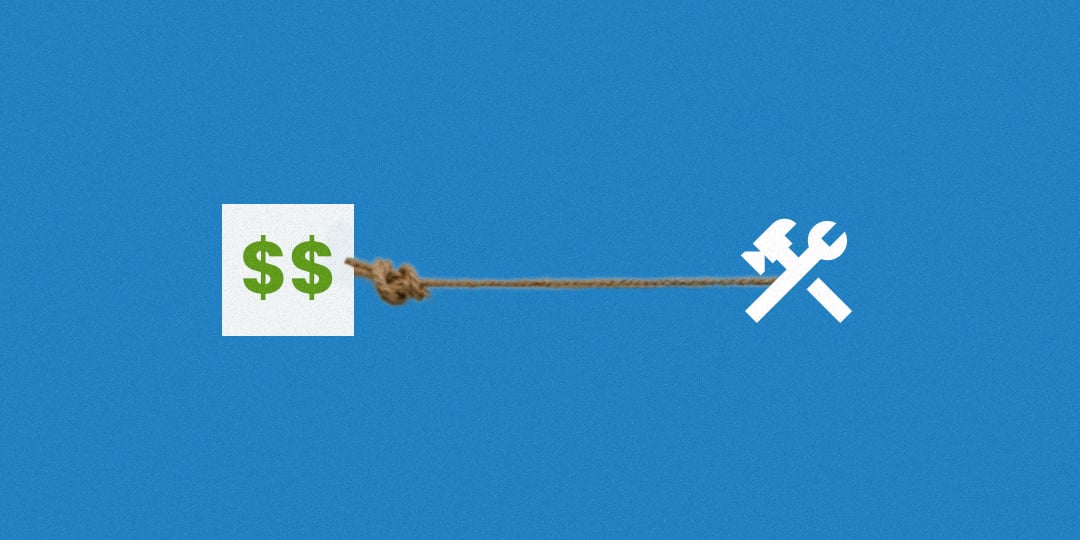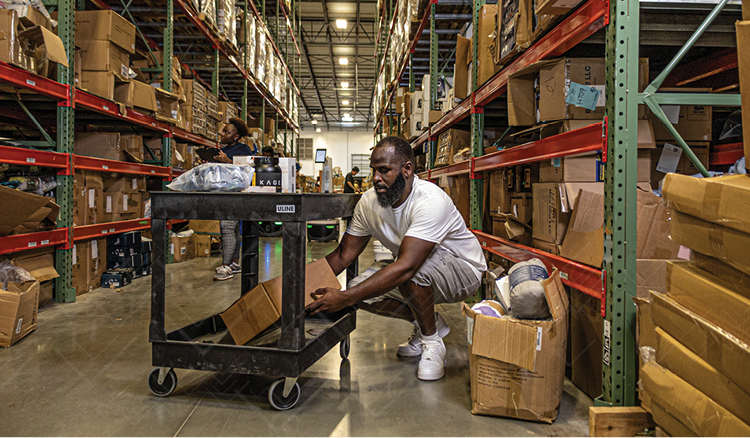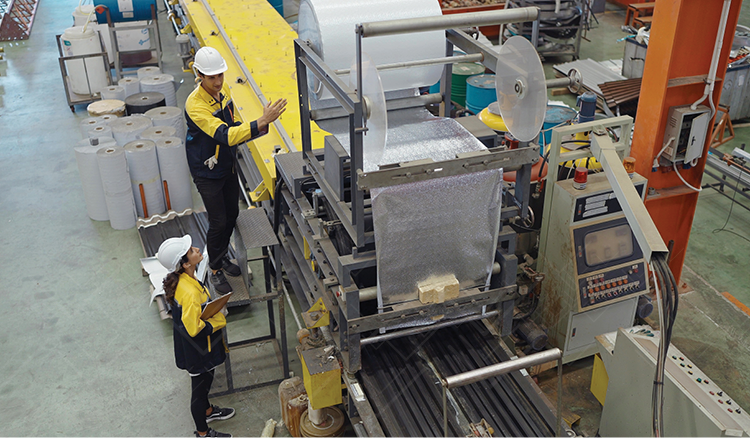Pull Production Systems: Push vs Pull, Types, and Tools
Stacking inventory as a buffer is a common practice, but it often goes too far. In the worst cases, businesses produce everything ahead of time and then hope to sell it all, only to find that engineering made an urgent modification to the product or that the forecasts were way off.
If you’ve ever found yourself in this scenario, you would have benefited from a pull system.
At Veryable, we support pull systems because they support agile production and reduce waste. The on-demand labor model we preach is an evolution of Lean thinking that empowers pull systems to become even more efficient. But we’ll keep the focus of this article on pull systems.
In this article, you’ll learn what pull production systems are, how to implement and manage a pull production system, and how to get the most out of them.
Pull production systems vs push production systems
Pull production systems differ from push production systems in that pull systems produce based on what the customer orders, whereas push systems produce based on a best guess about what the customer will order.
Push production systems are typically used when a business feels safer if it stocks inventory ahead of when the customer orders. Many businesses don’t believe they can produce customer orders quickly enough to fill them as they come in, so they produce their goods up front and hope to sell them all.
Pull systems, on the other hand, are typically used when a business knows it can produce what the customer orders quickly enough to maintain good service levels. Then the business does not have to guess how many orders will be placed. They can simply wait until they get orders to begin production. This reduces wasted inventory and allows the business to operate more efficiently while satisfying customer demands.
How to know if you’re ready for a pull production system
Before you start establishing a pull production system, there are other foundational Lean practices you should implement to improve your operations. These steps will set you up for future success and prepare you to implement a pull production system.
Your first steps toward establishing Lean (before using a pull system) should be:
- Establish a 5S practice
- Implement a total productive maintenance (TPM) program (if you are an equipment-intensive business)
- Standardize work
- Instill kaizen thinking and practice kaizen events
- Level your production
- Establish flow by eliminating production constraints and creating flow cells
After you have completed these six steps, you’re ready to implement a pull production system.
Types of pull production systems
There are three main types of pull production systems. Each has its own advantages and applications, so consider this before choosing one. Ultimately, we believe that any pull system will serve your company better than a push system.
Supermarket pull system (a-type)
The supermarket pull system is based on replenishing a collection of items that sits after each process step. In this system, individual process steps on the production line only work on an item when they need to replenish what was taken by a downstream process step.
The origin point of all these requests is the customer order, which the scheduler uses to create the appropriate kanban cards and fill the heijunka box. (We’ll explain kanban cards and heijunka boxes further below.) Then the requests move upstream from there, as each process step takes what it needs from its supermarket.
A downstream process step pulls from an upstream process step, triggering a replenishment process that requires that process step to pull from even further upstream. In this way, products are pulled through the system by the customer’s order.
Sequential pull system (b-type)
A sequential pull system is used when a supermarket system isn’t feasible because the wide range of parts makes holding a supermarket inventory after each process step difficult or costly.
The sequence of production is typically determined at the beginning of each shift. Instructions are passed with each item down the line in the form of a sequence list. Workers must maintain first-in, first-out production to avoid confusion and ensure adherence to the sequence list.
A sequential pull system has more room for error and requires more time and effort from management than a supermarket pull system, so it is not preferred as a standalone solution.
Mixed supermarket and sequential pull system (c-type)
A mixed pull system combines the best parts of a supermarket system and a sequential pull system. This is typically used when a facility produces one item that makes up a majority of their sales and some mixture of other items in smaller quantities.
A mixed pull system allows you to use a sequential list when needed for less common items while allowing your “big seller” to be produced using the standard replenishment cues from the supermarket.
The parts of the mixed pull system can be applied selectively, so that your facility can find the right mix it needs to ensure a smooth flow of value for all its products.
A mixed system is inherently more complex that implementing just one of the other pull systems. This means you will need to invest more time and effort into setting up and improving your mixed pull system. It also means that workers might have a harder time seeing mistakes or knowing when to trigger a halt to the line to address errors. This system will be more advanced and would benefit from supervision by an experienced Lean practitioner.
Tools for implementing a pull production system
When you implement a pull production system, it’s not as simple as clapping your hands and saying “alright, let’s do a pull system.” You’re going to need some way of implementing and managing your new method of production, especially if it’s a drastic change from the usual way of doing things.
Managing a pull production system is much easier when you choose an established framework such as kanban or CONWIP. Let’s explore each briefly.
Kanban and Heijunka Boxes
Kanban cards are a powerful tool for implementing a pull system. The cards visually represent items and are used to trigger processes at each step of the production line. When used properly, they ensure that no work is done without a purpose. Make sure to check out our guide with step-by-step instructions on how to implement Kanban.
A kanban card is a signal that upstream processes should begin work to replenish an established store of the item represented on the card.
There are many kinds of kanban you can implement. Triangle kanban, two-bin kanban, and two-card kanban are the most common. Each has its advantages and is best suited to a different environment, so you can choose the one that works best for you.
Heijunka boxes can be used in conjunction with kanban cards to set the production schedule for the shift. Implementing a heijunka box should be the last step of building your pull system.
When using a heijunka box, the planner puts the kanban cards into the heijunka box at the beginning of each shift to represent what parts need to be produced. This also establishes the order and cadence of production for the day by feeding the system at the “pacemaker” step in the process. This is typically near the end of each line.
The pacemaker will pull the appropriate kanban card from the heijunka box whenever they have capacity to do so. This will trigger the typical domino chain of upstream requests to replenish supermarkets.
It is worth noting that a heijunka box is different from the high-level heijunka practice of production leveling over a period of months. We do recommend a heijunka box, but we have a stance against heijunka production leveling at the horizon of months.
CONWIP
CONWIP, which stands for constant work in process, is a kanban system using generic cards (not specific to a product) that is typically applied in job shop environments where each order is highly customized. It is used less commonly than other kanban systems.
CONWIP implementation involves setting a fixed amount of cards that will be in the system and creating a system entry point at the beginning of the line. The card follows the product or container through the system to the end.
Each time a kanban card is detached because its product has been sent to finished goods, the card is sent back to the beginning of the line. The catch with CONWIP is that the cards do not represent a specific part to be produced. The cards must be assigned to a part from the backlog at the system entry point.
CONWIP requires more human input to determine what should be produced. While it is arguably simpler than traditional kanban, this room for error causes concern for some managers.
How to get the most from a pull production system
To get the most from your pull production system, the next step is to establish a pacemaker for your system.
The pacemaker receives the shift’s leveled production from the scheduling or shipping department to establish an authoritative production schedule for the shift. The schedule is automatically controlled by the established pull system, and having one entry point for orders into the system reduces complexity and confusion.
The next step after implementing a pacemaker is to establish a “milk run” system, which allows your workers to remain focused on their value-add work in the value stream while other workers move kanban cards and materials between stations in a continuous cycle.
It sounds like quite a bit of work, and frankly, it is. But the rewards are so great that if you stick with it, implementing a pull production system and continuing your Lean journey will be worth it.
How Veryable can help you with pull systems
“Flow where you can, pull where you must” is a common adage in Lean thinking. It highlights two important concepts. One, lean is a journey of continuous improvement. Implementing spot improvements and building upon them in pursuit of a larger vision is a critical part of learning. You cannot jump straight to single-piece flow but working towards that by implementing pull systems and refining them will get you further with a higher chance of sustaining those improvements. Two, the deployment of this tool will highlight waste. This concept is focused on directly and indirectly reducing inventory (and all of the other wastes associated with it). Being able to see that waste, understand it, and work it out is a very important lesson in lean thinking.
Veryable has several tools that will help identify waste, enable operations to quickly take action on it, and put in a sustainable process to keep that waste from creeping back in. Labor is an enormous cost for any operation and one of the biggest drivers in service levels, and having too much or too little at any given point can impact supplier scorecards as well as the ledger. Don’t call yourself lean if you don’t use on-demand labor, Veryable’s suite of tools enables a Just In Time approach to your workforce protecting cost and enabling reduced lead times and perfect service.
Here is a brief overview of the platforms…
Veryable's On-Demand Labor Marketplace
Labor will directly or indirectly touch every aspect of your operational performance. It is also one of the largest expenses on your P&L. Ignoring opportunity or being comfortable doing things the way they've always been done makes it just that much harder to find net improvement elsewhere. Leveraging Veryable’s On-Demand Labor Marketplace to build a flexible extension of your full-time workforce will allow your team to precisely match labor capacity to demand on a daily basis. Adopting this approach gives your operations leaders the resources they need to deliver the maximum return for the business and the most value for the customer.
Veryable's Workforce Management Tool
Veryable’s Workforce Management Tool ties together multiple systems (ERP, WMS, MES, HRIS, etc.) to use real-time data to automate the labor planning process and guide your leadership in making better critical decisions. This eliminates guessing, protects against costly forecasting inaccuracies, and enables performance-based decision making without the burden of manual spreadsheet updates or back-of-the-napkin estimating. This tool can operate as a stand alone platform for your full time employees, or you can access Veryable's on-demand marketplace from within this tool to fill any gaps in your operation on short notice. The best part is, you'll be able to view real-time performance data in just clicks for both full time employees as well as Veryable Operators.
Together these systems truly optimize every labor dollar spent across your footprint. This enables better visibility to translate best practices, and can act as a roadmap for continuous improvement.
For more information, visit our Lean Center of Excellence Homepage or our homepage for Continuous Improvement, Operational Excellence, and Lean Professionals.
Previous Posts
How Policy Constraints, Not Just Production Bottlenecks, Threaten Your Bottom Line
The Future of Manufacturing and Logistics
Create a free business profile today to explore our platform.






